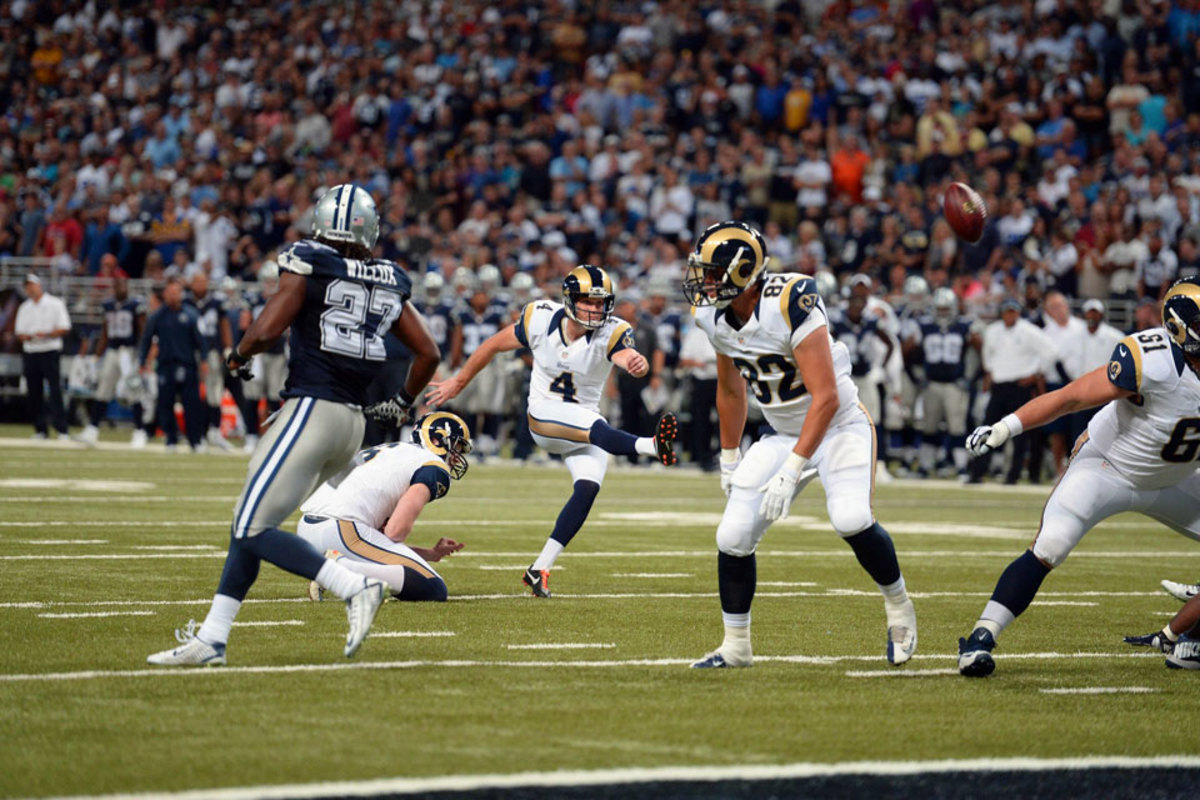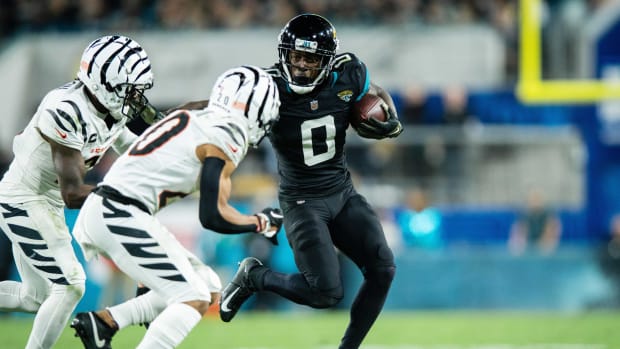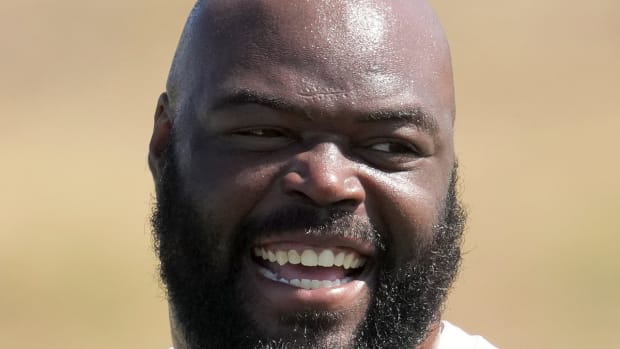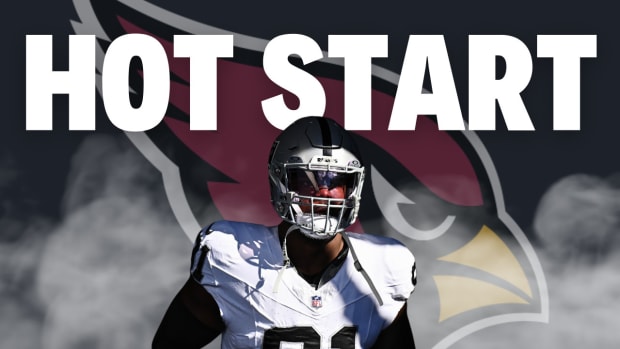
Fixing the Most Boring Play in All of Sports
In 1912, eight years before the birth of the professional football association now known as the National Football League, the system of scoring that would serve the pro game was adopted. The touchdown was changed from five to six points, a two-point safety was added, and the field goal and point-after-touchdown remained at three points and one, respectively.
Today at the Ritz Carlton Hotel in San Francisco, there’s a good chance the NFL’s 32 owners will vote for the biggest change in scoring in 103 years. It’s not quite a revolution, but when kickers are well nigh perfect with chip shots—they’ve made 99.5 percent of extra points over the past four seasons—it’s time for the league to do something to make the PAT remotely interesting.
• PETER KING’S MONDAY MORNING QUARTERBACK: Robert Kraft is talking, and he’s pretty peeved
The owners are slated to hear three proposals—one from the NFL’s Competition Committee, one from the Patriots and another from the Eagles that coincidental or not has Tim Tebow written all over it—starting at 5:30 p.m. ET today. And with pressure from the league office to change the scoring system after touchdowns, it’s thought to be very likely that one of the three proposals will be passed either late today or by the conclusion of the two-day meetings on Wednesday.
The pressure, one club official said, is not particularly overt. But this club official also said it’s no secret that Roger Goodell has been pushing the Competition Committee to work on a rule that will make the PAT something other than the most boring play in the nation’s most popular sport. And the Competition Committee, most notably co-chair Rich McKay of the Falcons and Mike Brown of the Bengals, has been trying to make something happen with extra point over the past several years. It’s the play fans use to refresh their beers, to use the bathroom, to check fantasy lineups … and then comes one of 20 TV timeouts per game.
• ALSO ON THE MMQB: From the draft to Dallas, retracing the crazy saga of LSU’s La’el Collins
Following a season in which just 59 two-point conversions were attempted—teams made 28, a success rate of 47.5 percent—three similar proposals, each with its own distinction, are up for debate. A three-quarters vote by the owners is needed to pass a new rule, meaning one of these proposals needs 24 votes to be enacted.
A look at the three plans…
The Competition Committee proposal
After scoring a touchdown, the offensive team would choose whether to go for one, a PAT kick, with the ball at the 15-yard line, or go for two from the 2-yard line. The PAT kick would essentially be a 32- or 33-yard attempt.
If the kick is blocked or the two-point try is fumbled or intercepted, the defensive team could run the ball back to the opposite end zone for two points.
The change would be for the 2015 season only, meaning if the owners wanted to continue it in 2016, they would have to vote it into the game again. This would be a one-year trial, with fixes possible after seeing potential problems this fall.
The New England proposal
Same as the Competition Committee’s proposal, with two exceptions:
- The defensive team cannot score points by returning a failed PAT or two-point try.
- The rule would be permanent; getting rid of it in future years would require 24 team votes.
The Philadelphia proposal
The Eagles also propose the PAT be snapped from the 15-yard line but want the line of scrimmage for the two-point conversion to be the 1-yard line. Any missed conversion returned to the opposite end zone would result in two points for the defense. The change would apply only to the 2015 season.
The Baltimore Colts’ Lou Michaels kicks an extra point against the Cleveland Browns at Municipal Stadium in 1968 NFL Championship Game. The Colts won, 34-0, and went on to play Joe Namath’s Jets in Super Bowl III. (Neil Leifer/Sports Illustrated)
Four points of interest:
1) The line of scrimmage for the two-point play has been the biggest haggling point. In March, at the league meetings, one GM proposed the line of scrimmage for two points be either the 1.5- or the 1.75-yard line. Why? Because there’s a feeling that plays run from the 2-yard line would result in about a 50-50 conversion rate, which would push leery coaches to the more sure thing—the PAT. In essence, because GMs and coaches and owners couldn’t agree on putting the ball at the 1-, the 1.5- or keeping it at the 2-yard line, it was kept at the two in two of the three proposals. But who’s to say this couldn’t change during a debate in San Francisco today?
2) I think it’d be an upset if the Eagles’ plan passed, in part because of fear of injury to quarterbacks. Think of Chip Kelly taking starting quarterback Sam Bradford off the field for two-point conversion plays, and subbing in the multifaceted Tebow for:
- a quarterback keeper.
- a fake dash into the line, followed by a jump pass into the end zone, something Tebow used successfully several times at Florida.
- a la Tom Brady, the simple act of piercing the goal line with a quick jump and extending the ball over the line before pulling it back.
- rolling left with five receivers on the field, and either throwing it or keeping it with a wide run and bull-rush into the end zone.
Of course, if Mark Sanchez wins the backup job in Philadelphia and Tebow doesn’t make the Eagles, Sanchez is quick enough to do some of the change-up stuff for the two-point play as well.
But—and this is a big but—I’ve talked to some decision makers who think there will never be a two-point play from the one-yard line for a simple reason: too much risk for quarterbacks. Imagine if a quarterback gets a reputation for quick-snapping at the 1-yard line and shoving the ball over the line and quickly pulling it back. Think of the defensive plan to stop that. My guess is that many foes would have 250-pound middle linebacker types time a rush with the snap of the ball, intending to blow up the middle of the line—and to clock the quarterback on a sneak. There’s too much chance for injury, I think, for the Eagles’ plan to win the day today.
Talk Back
Have a question for Peter King? Send an email to talkback@themmqb.com and check back on Wednesdays to see if it makes The MMQB mailbag. Please include your name and hometown.
3)
The Competition Committee clearly views its plan as a starting point, a trial for a year. The committee understands that more than nine of 10 field goals from the 32- and 33-yard range are made (90.1 percent of all 30- to 39-yard field-goal attempts were successful last season). Setting the proposal for one year only is intended to get coaches accustomed to a longer PAT, and to the strategies they might use. For instance, what if a coach believes that, with practice, his team can convert six of 10 two-point plays, on average? If that happens, a coach might be more inclined to consistently go for two, except when one point is needed for strategic reasons late in games.
4) Who doesn’t want a chance for the defense to be able to score on a conversion? If the defensive team knows a blocked kick and a return to the opposite end zone would result in two points, wouldn’t that alone make a boring PAT more interesting?
* * *
The proposal with the best chance to pass is probably the Competition Committee plan, if only because the prospect of New England’s permanent idea will be troubling to some who aren’t enthused about changing the PAT in the first place. And so the idea of putting a plan in place that would require 24 votes to kill it next year is something that, I believe, would make more than a few owners skittish.
My problem with the Competition Committee plan is that it doesn’t go far enough. If a coach thinks he has a 90 percent chance to score one point, and a 50 percent chance to score two, most coaches—and they are largely a conservative sect—will opt for the relatively sure thing: the PAT. I’d have pushed the kick back even farther, another five, seven or even 10 yards. If the league is trying to inject exciting plays into the game, there should be ample motivation for a coach to go for two.
• ALSO ON THE MMQB: 10 Things I Think I Think, by Jenny Vrentas
That’s why I think it’s important that this proposal be for 2015 only, and to think of the plan for the extra point to be a progression. If the proposal is passed for 2015 only, it will be relatively easy next year to tinker with the PAT—meaning it could be pushed back so that teams start going for two more often in 2016.
Anything that brings more strategy and more potential drama into the game, I’m all for it. If we have to wait until 2016 to max out on strategy, it’ll be worth the wait. This year’s plan is a good starting point.
Follow The MMQB on Facebook, Twitter and Instagram.
[widget widget_name="SI Newsletter Widget”]






































